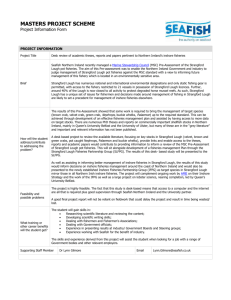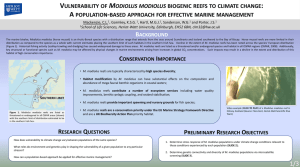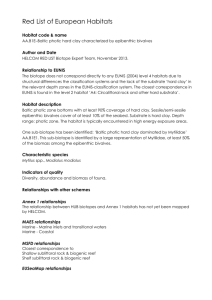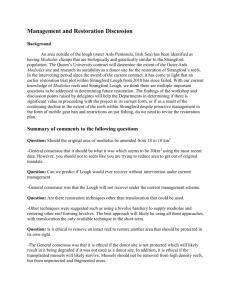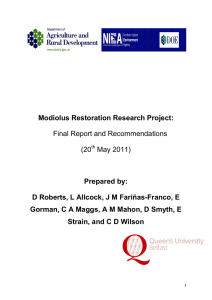Modiolus Restoration Plan - Queen`s University Belfast
advertisement
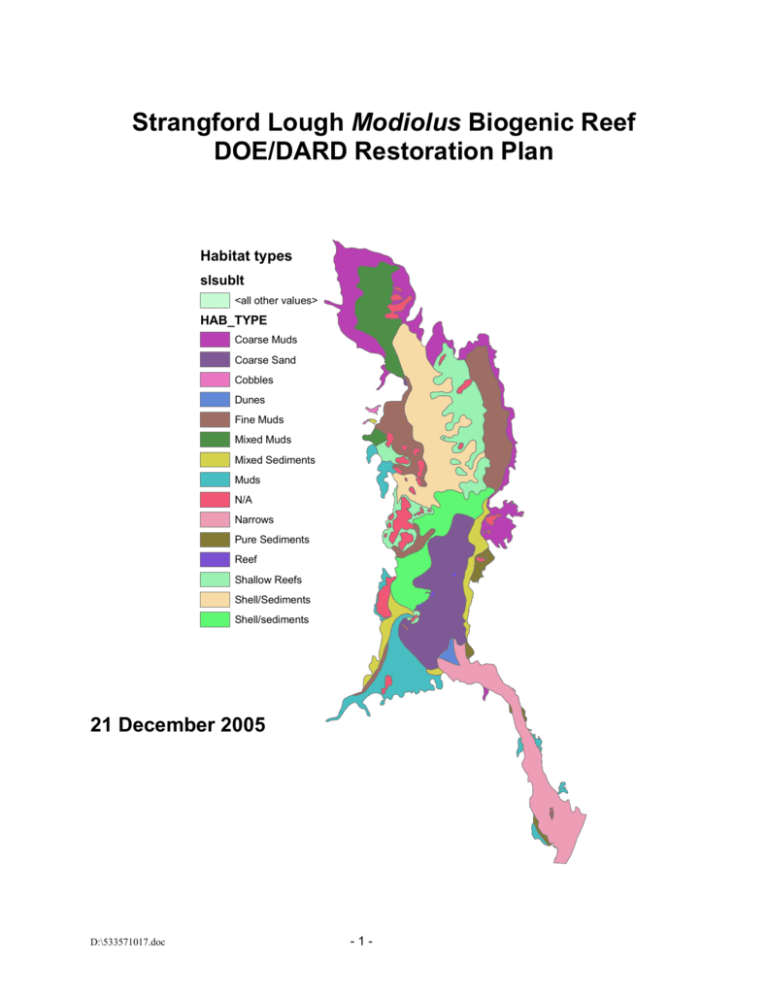
Strangford Lough Modiolus Biogenic Reef DOE/DARD Restoration Plan Habitat types slsublt <all other values> HAB_TYPE Coarse Muds Coarse Sand Cobbles Dunes Fine Muds Mixed Muds Mixed Sediments Muds N/A Narrows Pure Sediments Reef Shallow Reefs Shell/Sediments Shell/sediments 21 December 2005 D:\533571017.doc -1- CONTENTS BACKGROUND 3 OBJECTIVES 4 ELEMENTS OF THE RESTORATION PLAN 6 IMPLEMENTATION 9 (1) Protection 9 (2) Monitoring 9 (3) Intervention Action 10 (4) Proposed implementation team 10 TIMETABLE 12 PROJECT COSTINGS 13 FIGURE 1. INTER-RELATIONSHIPS OF THE ACRONYMS 14 APPENDIX 1. 15 APPENDIX 2: DEFINITION OF CONDITION STATUS 16 APPENDIX 3: TERMS OF REFERENCE FOR THE INTER-DEPARTMENTAL STRANGFORD LOUGH RESTORATION IMPLEMENTATION GROUP (SLRIG) 17 APPENDIX 4: PRELIMINARY GANNT CHART 18 D:\533571017.doc -2- BACKGROUND Modiolus modiolus, the horse mussel, forms the basis in Strangford Lough for a feature described as biogenic reefs. These are mound-like layered structures built by and predominantly composed of organic remains such as shells and skeletons of sedentary organisms which form a habitat for other marine organisms that has the effect of increasing levels of biodiversity. The full citation for the Strangford Lough Special Area of Conservation (SAC) can be found on the Joint Nature Conservation Committee website at www.jncc.gov.uk/ProtectedSites/SACselection. The part referring to reefs is given in Appendix 1. While Modiolus itself is ubiquitous throughout the North Atlantic, it is the clumped biogenic reef-forming variant on a muddy sea bed that is rare which resulted in it being listed as one of the Annex 1 Habitats Directive selection features of the Strangford Lough SAC. Modiolus has been documented in the Lough since the mid-nineteenth century and research conducted in the 1970’s showed Modiolus reefs to be extensive. The full extent of these reefs were not mapped until the 1990’s, by which time it was evident that the beds had been already significantly impacted by activities such as dredge/trawl fishing. Following concerns raised by various Non-Governmental Organisations (NGOs) and others, the Department of the Environment (DoE) commissioned Queen’s University Belfast (QUB) in 2003 to investigate both the current status of the reefs and identify probable causes of their demise [Strangford Lough Ecological Change Investigation (SLECI)]. An interim report in November 2003 identified trawling as the single most likely causative factor resulting in the Department of Agriculture and Rural Development (DARD) introducing a total ban on all mobile fishing gear within Strangford Lough from December 2003. QUB reported their full findings in June 2004 painting a picture of widespread damage to the Modiolus biogenic reef feature. The draft Strangford Lough Management Scheme 2005-2010 Objective 1 clearly identifies Actions required by the Department of the Environment’s Environment and Heritage Service (EHS) and the Department of Agriculture and Rural Development (DARD) to address the restoration of Modiolus Biogenic Reefs within Strangford Lough. This Restoration Plan is in accordance with a significant component of Objective 1 of the Scheme. Objective 3 of the Management Scheme is also considered with reference to management of environmentally sustainable fisheries. The purpose of this project is to set out the mechanisms by which the Competent Authorities within Northern Ireland will attempt to restore Strangford Lough Special Area of Conservation (SAC) to Favourable Conservation Status (FCS). D:\533571017.doc -3- The basis of this proposal is to spend the next five years ensuring maximum protection for the remaining reefs and the sites at which they were known to have recently occurred, while monitoring the rate of natural recovery. This period will be used to pilot suitable intervention techniques that will be needed if it is found that natural recovery is not happening satisfactorily. OBJECTIVES DOE/DARD have identified three prime objectives (one short term, one medium and one long term) for the Modiolus reef restoration plan to restore the biogenic reef feature The short term objectives are; to identify, map and introduce total protection for the remaining Modiolus biogenic reef sites within 1 year of adoption of this plan: damaged biogenic reefs will also be identified and protected from further damage to assess whether conditions in appropriate areas within Strangford Lough are currently favourable for restoration using pilot scale translocation experiments . The medium term objective is; to show, using appropriate reference and control sites, evidence of recovery of the Modiolus biogenic reef feature towards ‘Unfavourable Condition, Recovering’ within 5 years of initiation of this proposed plan. The long-term objective is; to restore the Strangford Lough Modiolus biogenic reef feature to ‘Favourable Conservation Status’. A factor causing difficulties/unknowns in investigations of Modiolus populations is the long life span of the species, typically living up to 70 years in Strangford Lough waters. Because of this, it must be recognised that restoration could be a lengthy process probably subject to constant modification resulting from additional knowledge and emerging technologies. A target date for the long-term objective will be offered on delivery of the shorter term objectives. Definitions of condition of interest features are detailed in Appendix 2, extracted from the Joint Nature Conservation Committee’s (JNCC – the UK advisors on nature conservation) Common Standards Monitoring (CSM) manual. D:\533571017.doc -4- There is some uncertainty as to the precise former location and extent of individual reefs . Modelling to hindcast where they might have been may be an option: however, in the interim, the best course of action is to revisit the habitat as described by the Ulster Museum in the Northern Ireland Sub-Littoral Survey (NISS, 1987). The unique assemblages associated with the Strangford Modiolus communities were fundamental in the identification of Strangford Lough as both a Marine Nature Reserve (1995) and Special Area of Conservation (1996). The goal is to restore the described communities to at least the sites identified by the Ulster Museum. Within the NISS publication ‘Inshore Marine Life in Northern Ireland (1990), the Modiolus beds are described as follows’: Extensive beds occur on soft shelly mud in areas of some tidal movement. The mussels and their dead shells provide a hard substratum which is richly colonised and highly productive. The clams Aequipecten opercularis and Chlamys are present and ubiquitous on the Strangford Beds. Also characteristic of these beds are several sponges, Mycale rotalis, Mycale macilenta, Mycale subclavata, Spanioplon armaturum, Iophon ingalli and Haliclona spp., also Alcyonium digitatum, Thyone fusus, Thyonidium commune and Pyura microcosmus. These species are found rarely or are absent from other Modiolus beds. Thyonidium and Pyura were particularly characteristic of this community, being recorded only rarely elsewhere. This description is compatible with a more recent multivariate analysis of available data carried out by DARD staff on behalf of the restoration group. As well as containing the above species, the beds also displayed a clumped nature so typical of the Modiolus populations in Strangford Lough. In summer 2005, a dive team found evidence to suggest that early stages of recovery following the ban on mobile gear may be occurring within the Lough. If, therefore, natural recovery has already commenced it may be prudent at the initial stages of the plan to hold back from more intrusive intervention, such as large scale re-seeding and/or translocation. The project will be overseen by an inter-Departmental Strangford Lough Restoration Implementation Group (SLRIG) under an independent chairperson with representatives from the Council for Nature Conservation and the Countryside (CNCC) and the Strangford Lough Management Advisory Group (SLMAC). See Appendix 3 for terms of reference. D:\533571017.doc -5- ELEMENTS OF THE RESTORATION PLAN At least three essential elements have been identified for the implementation of the restoration programme. These are: (1) Strict protection of the remaining extant Modiolus biogenic reefs and areas where they were previously reported within Strangford Lough through: o Maintaining the temporary ban on mobile gear o Establishing no-disturbance areas, including disturbance by anchoring, potting and diving o Reviewing possible impacts from extant consented activities, e.g. sewage discharges, commercial fishing and aquaculture These measures may require amended and/or new legislation where it is found that existing measures (including voluntary codes of conduct) are found not to be sufficient to control an actual or potential threat to the interest feature. (2) Monitoring of the effectiveness of protection measures including: o Compliance monitoring (policing of banned activities and activities within zoned areas) o Detailed reef mapping o Monitoring natural recovery (3) Intervention action. There is a need to identify methodologies aimed at artificially restoring the reef feature in the event of natural recovery failing to achieve a trend towards Favourable Conservation Status (FCS). These will include: o Pilot-scale studies to assess whether conditions in areas based on historical presence are currently favourable for Modiolus restoration. o Translocation of natural Modiolus reefs. o Experimental re-seeding of historical Modiolus reef sites.. This element will require the following lines of research: D:\533571017.doc Production of young mussels for re-seeding. -6- Establishing the most suitable sites for re-seeding and mussel recruitment . Creating favourable sites, through provision of artificial substrate for both wild and laboratory-reared seed. o Monitoring recovery at translocation sites and re-seeded areas. D:\533571017.doc -7- IMPLEMENTATION The implementation of each restoration element will require the following actions: (1) Protection Protection of the remaining undamaged sites will be vital in acting as these will act as reference sites for the whole restoration program. The two Departments need to identify shortcomings within the legislation to protect the Lough’s feature interests and amend or draft legislation quickly to ensure total protection. Without such protection any attempt at restoration will be compromised. (2) Monitoring Establishment of a database and an array of monitoring sites based on current condition and previous surveys such as Northern Ireland Sub-littoral Survey (NISS,1980’s) and Strangford Lough Ecological Change Investigation (SLECI, 2004) Regular monitoring will also identify any additional activities which might be damaging the sites, possibly leading to further protection through zoning or modification of existing consented activities. This equates to compliance and integrity monitoring of the biogenic reefs. Detailed mapping of the remaining good condition Modiolus sites and other Marine Nature Reserve/SAC features. Previous mapping studies within Strangford Lough have been conducted by remote acoustic techniques such as Roxann supplemented with grab sampling and towed video. A more effective method might be to use divers using underwater tracking systems to map boundaries visually. Coupled with this will be the establishment of fixed quadrat monitoring sites to enable assessment of local temporal change within sites. Appropriate monitoring of the epifaunal recovery at (a minimum of 20) historical Modiolus sites. This will be by replicated 100m transects surveys, following the approach developed by SLECI. Pilot studies in the first year and detailed monitoring over the five year period will inform on whether or not we have met the short and mid-term objectives, namely to halt the decline and determine if the Modiolus biogenic reefs are recovering. D:\533571017.doc -9- (3) Intervention Action There is a requirement to identify methodologies to restore reef feature in the event of natural recovery failing to achieve a reversal of the current situation. Research will also focus on identifying gaps in our knowledge of the ecological requirements needed to develop and sustain Modiolus based biogenic reefs and basic information on the biology of Modiolus modiolus and other key components of the biogenic reef. We also need to integrate this knowledge into practical intervention methodologies in the event of failure of natural recovery becoming apparent. Such methodologies may include: Translocation. Moving Modiolus clumps into degraded sites to assess if conditions at the damaged sites are conducive to recovery. In the event of insufficient resource within Strangford Lough, Modiolus from populations outside the Lough may be considered following appropriate biological screening. Control of predators within the experimental sites will also be considered. Re-seeding. Artificial production of seed mussels may be considered an option if sourcing of natural clumps of Modiolus in significant quantities is not possible. This element will require detailed studies of the early life history stages of Modiolus and whether or not cultured Modiolus will clump and attract epifauna typically associated with natural biogenic reefs. It is envisaged that the research will also assess the suitability of differing types of cultch or artificial substrate. Monitoring will assess survivability and likelihood of success if expanded up to large scale restoration. (4) Proposed implementation team A proposed method for implementing the restoration plan is through the establishment of a dedicated Modiolus Restoration Research Group (MRRG). Strategically, this would be most conveniently based in the Strangford Lough area. It is envisaged that the MRRG would consist of at least four personnel: Senior Researcher (post-doctoral level) Two Researchers (post graduate level) 1 Technician/Boatman (with appropriate certification) The ability to dive would be mandatory for at least three of the team. They would also need to be fully equipped with their own dive-boat, diving equipment, camera equipment, laboratory space and access to aquaculture rearing facilities. The Senior Researcher would report directly to a Departmental Project Client Officer. It is envisaged that the MRRG will initially be appointed for five years in order to deliver the D:\533571017.doc - 10 - short and mid- term objectives of the plan. Close Departmental management is also important to ensure that the work is focused on science required for delivery of the objectives and not distracted into nugatory research. It is envisaged that the MRRG will most conveniently be locally based. This would then enable the group to be in a position to advise the SLRIG of any areas of concern which may merit additional investigation/enforcement. D:\533571017.doc - 11 - TIMETABLE Figure 1 is provided to show the inter-relationships of the various groups discussed in this plan. It is accepted that to a large degree the course and progress of this work will be largely a ‘voyage of discovery’ so that a tight timetable cannot be provided at the outset. Appendix 4 is the beginnings of a Gannt table for the work, which will need to be further populated as the work progresses. The following milestones are identified to chart the progress of the Modiolus restoration programme. Immediate – review and investigate legislation and other administrative actions, including engagement with stakeholders for the delivery of voluntary Codes of Conduct. June 2006 - Establish MRRG, pilot studies and appropriate sampling protocols. July 2006 – Set-up publicly accessible website to report on progress of project, work program, location of experimental rigs, non-disturbance zones etc. December 2006 – produce a full and accurate map of the existing Modiolus biogenic reef habitat within Strangford Lough. December 2006 – Report on viability of Modiolus at various sites throughout the Lough June 2007 – Annual Report 1 June 2008 – Annual Report 2 June 2009 – Annual Report 3 June 2010 – Annual Report 4 June 2011 – Report on current status of Modiolus biogenic reef in Strangford Lough which should at least demonstrate ‘recovering status’ within the next Habitats Directive six-yearly reporting period (2007-2013). D:\533571017.doc - 12 - PROJECT COSTINGS It is estimated that the cost for this project, based upon the establishment of a dedicated team and an associated research program which potentially could extend to five years, will be high. The costs will however be reviewed on a regular basis depending on the success or failures of the research methodologies. Given the significant financial commitment, and recognising the fact the project will be overseen by the SLRIG, the Departments will detail an officer of appropriate grade and experience to manage the restoration plan (Project Client Officer). The Client Officer will project manage the MRRG and provide a secretariat for the SLRIG. The officer will also maintain a direct link with the European Commission to both advise on progress with the plan as well as provide early warning of technical/operational problems as they arise and suggest mutually agreeable solutions. Additional costs borne by the two Departments with regard to management of this project have not been detailed in this submission. D:\533571017.doc - 13 - FIGURE 1. INTER-RELATIONSHIPS OF THE ACRONYMS NORTHERN IRELAND EXECUTIVE DEPARTMENT OF THE ENVIRONMENT DOE DEPARTMENT OF AGRICULTURE AND RURAL DEVELOPMENT DARD Fisheries Division FD Environment and Heritage Service EHS Strangford Lough Management and Advisory Group SLMAC STRANGFORD LOUGH RESTORATION IMPLEMENTATION GROUP SLRIG MODIOLUS RESTORATION RESEARCH GROUP MRRG D:\533571017.doc - 14 - Environmental Protection Group EPG Council for Nature Conservation and the Countryside CNCC APPENDIX 1. Annex I habitats that are a primary reason for selection of this site 1170 Reefs Reefs in Strangford Lough vary from tide-swept bedrock and large boulders in the main channel of the Narrows, through sand-scoured bedrock and boulders at either end of the channel, to more sheltered bedrock and boulders in the main central portion of the Lough and in parts of the intertidal. Beds of horse mussels Modiolus modiolus form extensive biogenic reefs within the central portion of the Lough. Tide-swept bedrock is restricted to the Strangford Narrows, where rock surfaces are entirely clothed in suspension-feeding species, notably the soft coral dead-men’s fingers Alcyonium digitatum, sponges, especially Pachymatisma johnstonia and the rock-boring Cliona celata (which reaches massive proportions), ascidians, particularly Dendrodoa grossularia and Corella parallelogramma, and sea-anemones including Metridium senile. Very large boulders strew much of the bed of the Narrows, and are subject to strong tidal streams. These boulders are clothed with encrusting sponges, such as Myxilla incrustans and Myxilla fimbriata, with abundant hydroids, especially Tubularia indivisa, and sea anemones, including Sagartia elegans, Corynactis viridis and Actinothoe sphyrodeta. Coarse sand scours rock surfaces at the sides and either end of the Narrows. Here the characteristic species is the bryozoan Flustra foliacea. Though most of the intertidal zone is clothed in sediments, glaciated or sea-worn bedrock outcrops are found at many locations. Massive boulders (glacial erratics or the cores of eroded drumlins) occur on the shore and form rocky islands known as ‘pladdies’. Whilst Silurian rocks predominate, there is sandstone at Mountstewart and limestone at Limestone Rock. The fauna and flora associated with these outcrops are dependent on the rock type, the angle of bedding-plane and degree of weathering, the position on the shore, and the degree of exposure to currents and waves. Full development of the climax biotope associated with the M. modiolus beds depends on the very sheltered, plankton-rich waters of extremely low turbidity found in the central to northern area. M. modiolus rarely occurs in such still waters. The mussels and dead mussel shells provide a hard surface in an otherwise soft-sediment environment on which numerous other species (up to 100) depend. Many mobile suspension-feeders also occur, particularly the scallop Chlamys varia which is co-dominant with M. modiolus. A similar biotope, also dominated by M. modiolus, but with brittlestars Ophiothrix fragilis and Ophiocomina nigra replacing C. varia as co-dominant, occurs in the central to south-western area where water movement is slightly greater. D:\533571017.doc - 15 - APPENDIX 2: DEFINITION OF CONDITION STATUS The following categories are used to describe the condition of interest features as detailed in JNCC’s Guidance on Common Standards Monitoring: http://www.jncc.gov.uk/page-2217. Favourable - maintained. An interest feature should be recorded as maintained when its conservation objectives were being met at the previous assessment, and are still being met. Favourable - recovered. An interest feature can be recorded as having recovered if it has regained favourable condition, having been recorded as unfavourable on the previous assessment. Unfavourable - recovering. An interest feature can be recorded as recovering after damage if it has begun to show, or is continuing to show, a trend towards favourable condition. Unfavourable - no change. An interest feature may be retained in a more-or-less steady state by repeated or continuing damage; it is unfavourable but neither declining or recovering. In rare cases, an interest feature might not be able to regain its original condition following a damaging activity, but a new stable state might be achieved. Unfavourable - declining. Decline is another possible consequence of a damaging activity. In this case, recovery is possible and may occur either spontaneously or if suitable management input is made. Partially destroyed. It is possible to destroy sections or areas of certain features or to destroy parts of sites with no hope of reinstatement because part of the feature itself, or the habitat or processes essential to support it, has been removed or irretrievably altered. Destroyed. The recording of a feature as destroyed will indicate the entire interest feature has been affected to such an extent that there is no hope of recovery, perhaps because its supporting habitat or processes have been removed or irretrievably altered. D:\533571017.doc - 16 - APPENDIX 3: TERMS OF REFERENCE FOR THE INTER-DEPARTMENTAL STRANGFORD LOUGH RESTORATION IMPLEMENTATION GROUP (SLRIG) Background The SLRIG has been established in response to the decline of the ‘Modiolus modiolus’ biogenic reef communities in Strangford Lough. The working group will be governed by obligations from Articles 2 and 6 of the Habitats Directive (restoration and non-deterioration) and Article 39 of ‘The Environment (Northern Ireland) Order 2002’ (Duties of Public Bodies). The group will consist of representatives from DARD Fisheries Division, DOE Environment Policy Group and EHS Natural Heritage Directorate. Additionally, the Strangford Lough Officer (representing SLMAC) and a representative of the CNCC will be invited to attend appropriate meetings of the group in an advisory capacity. The group is currently chaired by Professor Ray Seed of Bangor School of Ocean Sciences, University of Wales-Bangor. Remit The group shall report to the DOE and DARD. The group shall consider all reasonable ways to restore the Modiolus modiolus’ biogenic reef communities in Strangford Lough to Favorable Conservation Status The group shall consult with key stakeholders in Strangford Lough. The group shall make recommendations to both Departments on its preferred method of protection and restoration, which should include an indication of the expected timescale for the project and approximate costs. The group shall provide a detailed implementation plan for consideration by both Departments. The group shall oversee and direct all commissioned research and monitoring linked to the restoration of Modiolus biogenic reefs. D:\533571017.doc - 17 - APPENDIX 4: PRELIMINARY GANNT CHART To be further populated later. Year 1 Administration Year 2 Year 3 Administration Administration Food (POC, SPN, Plankton) Quality Monitoring-from JSLP Food (POC, SPN, Plankton) Quality Monitoring-from JSLP 1. Restrict pot fishing in pristine area 2. Legislate to restrict anchoring 3. Legislate to restrict diving 4. Obtain funding 5. Obtain Crown Estate lease 6. Obtain consent under Fisheries Act Design and deliver projects to: 1. establish the potential survival at reference sites through sentinel populations. 2. link SMILE hydrodynamics 3. use SMILE to assess feeding/energy requirements of Modiolus 4. establish genetic variability and potential translocation populations. 4. determine whether aquaculture techniques can provided additional juveniles for reseeding trials 5. include Modiolus on algal toxin monitoring programme 6. review pathology reports Community analysis in “artificial habitat v “real” Re-stocking trials Algal toxin analysis Algal toxin analysis Survey/ model to determine: Survey to determine: Survey to determine: 1. the current spatial distribution of Modiolus and its status 2. the potential spatial distribution of Modiolus. 3. create a central database 4. establish the statistical design of sampling programme 1. Increase in spatial distribution of Modiolus. 1. Increase in spatial distribution of Modiolus Identify reference areas within the potential area and record: Survey to determine: Survey to determine: 1. increase in numbers of Modiolus 2. increase in numbers/density of associated species 1. increase in numbers/density of Modiolus 2. increase in numbers/density of associated species 1. numbers/density of Modiolus in reference areas. 2. numbers /density of associated species in reference areas 3. establish appropriate statistical protocols D:\533571017.doc - 18 -

